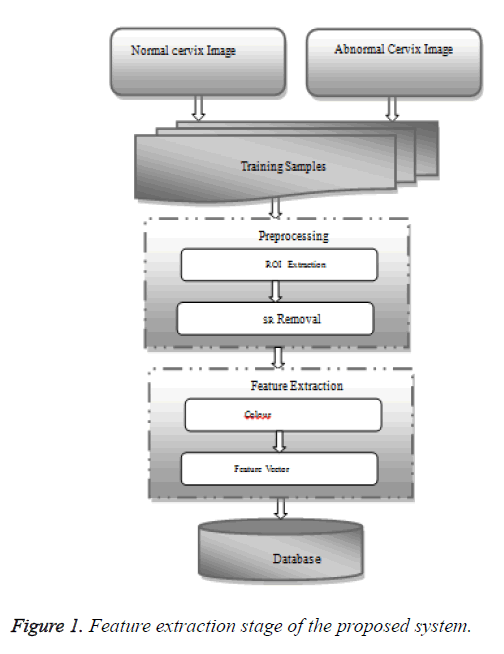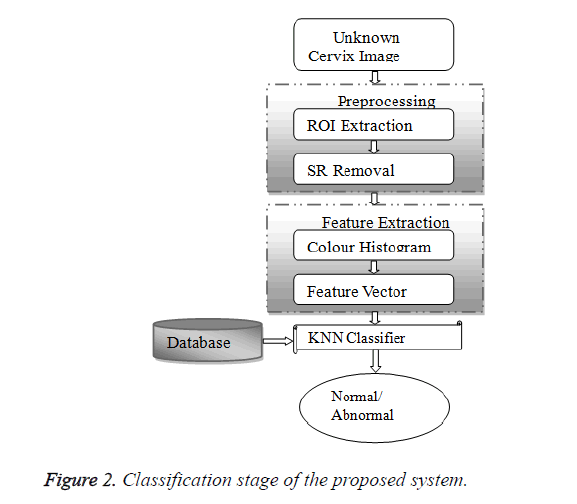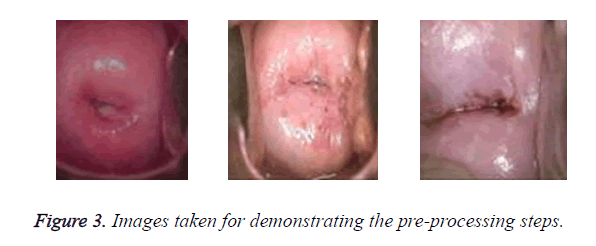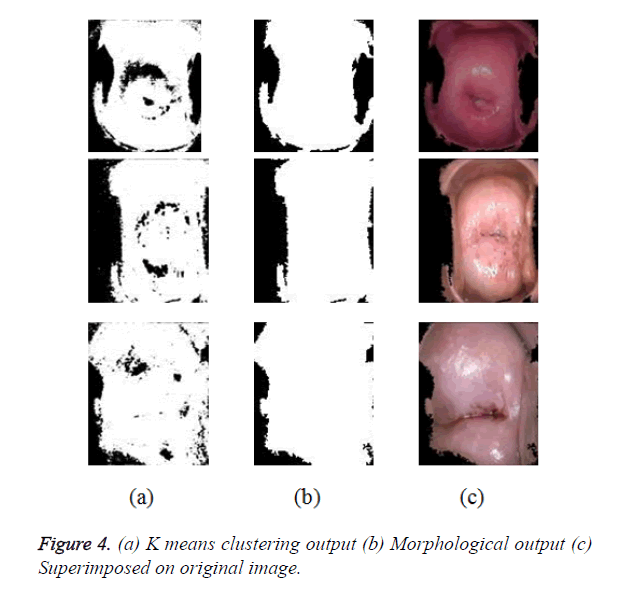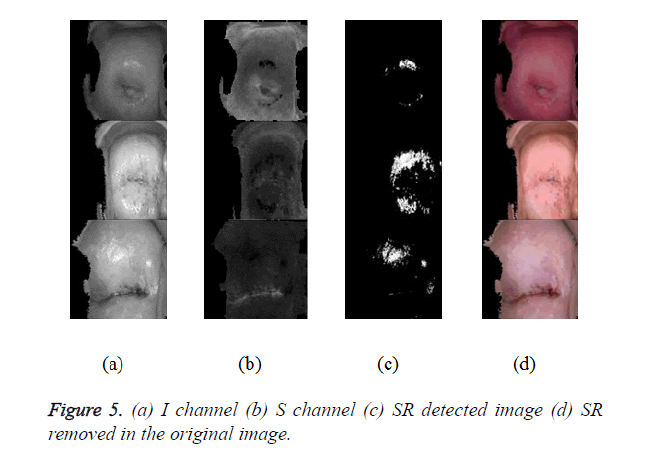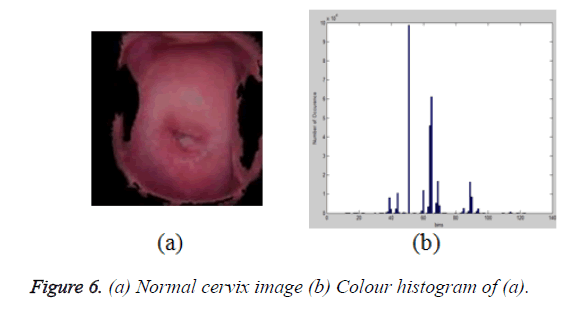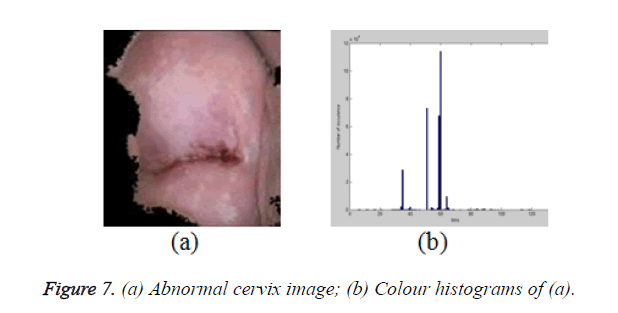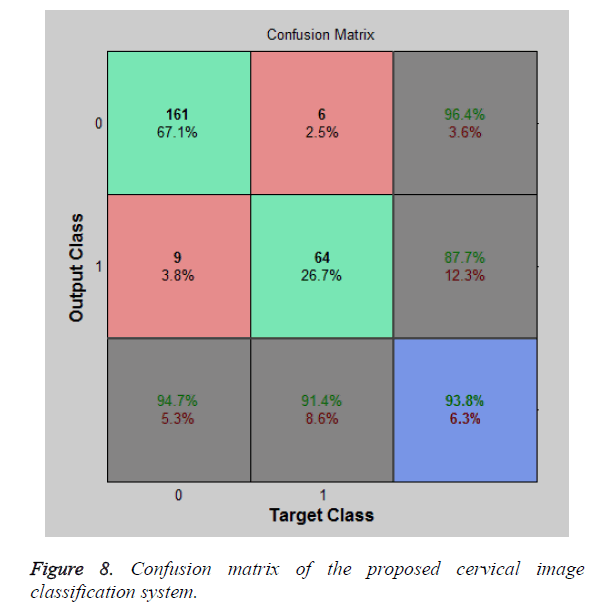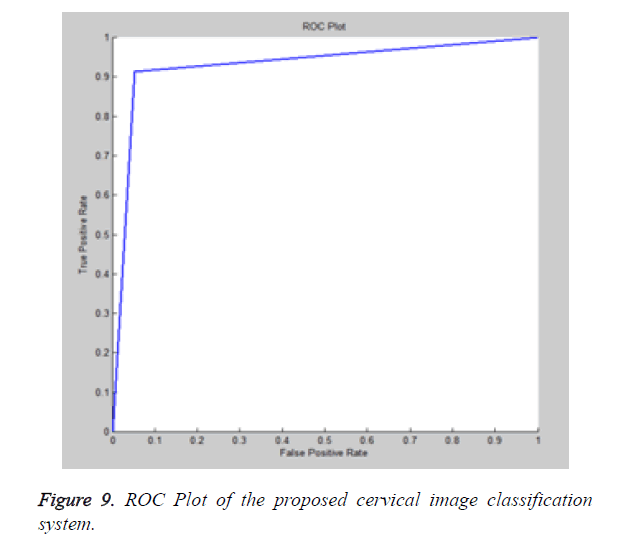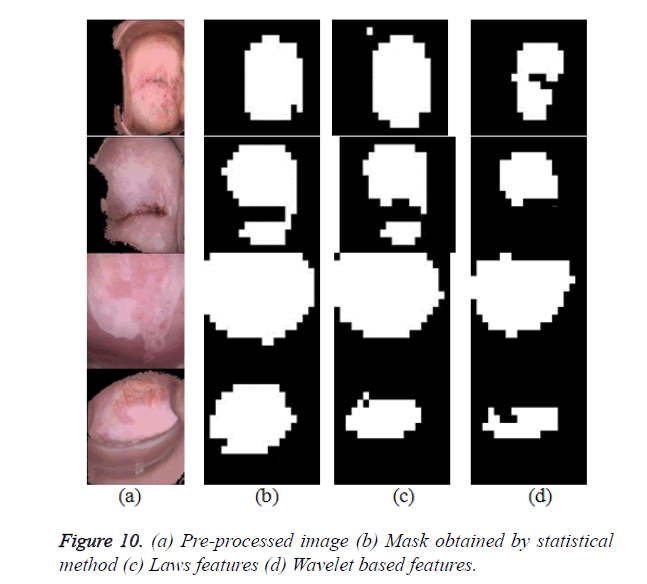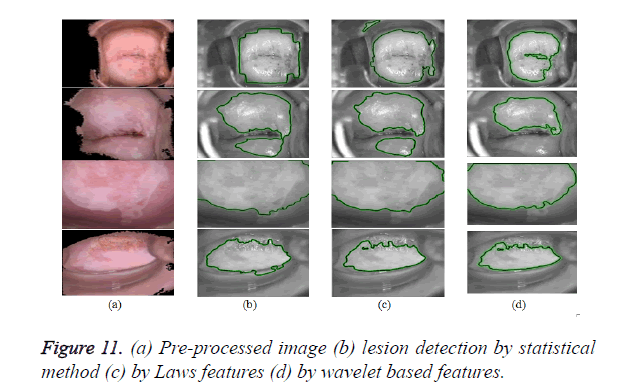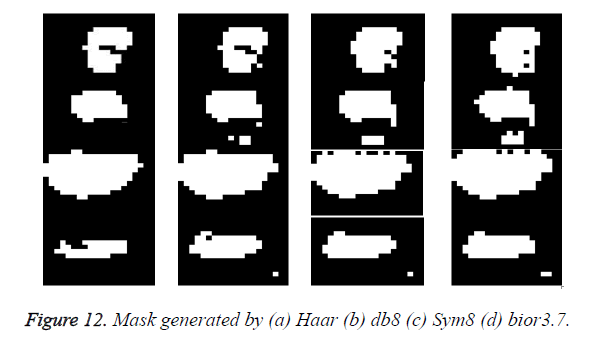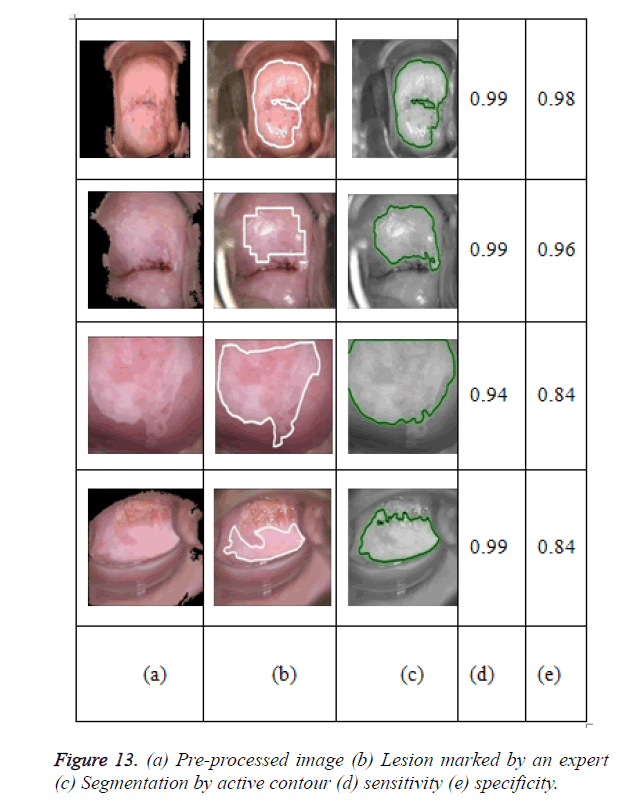Research Article - Biomedical Research (2017) Artificial Intelligent Techniques for Bio Medical Signal Processing: Edition-I
Effective lesion detection of colposcopic images using active contour method
Ramapraba PS*, Chitra MP and Prem Kumar MPanimalar Institute of Technology, Bangalore Trunk Road, Varadharajapuram, Poonamallee, Chennai, Tamil Nadu, India
- *Corresponding Author:
- Ramapraba PS
Professor/HOD, Panimalar Institute of Technology
Tamil Nadu, India
Accepted on February 23, 2017
Abstract
In the field of medical imaging, fully automated processing of medical images has become the need of the hour. This demand has led to the development of several techniques to detect abnormalities in digital images. This research paper aims to develop an automatic system for detecting lesion in digital cervical Colposcopic images. Through research works reviewed significantly, available cervical cancer detection schemes employ Discrete Wavelet Transform (DWT) as the major feature extraction technique and active contour technique as a lesion detection technique. As discrete wavelet transform is a frequency domain analysis technique, features are extracted and stored in the database which is required for lesion detection. Further, the affected area in the cervical image is detected by active contour method. Simulation results are obtained by using K Nearest Neighbor (KNN) classifier which provides visual information about lesion in the cervical image with increased accuracy, precision, sensitivity, specificity in comparison to the results obtained by using statistical features, laws and wavelets.
Keywords
Active contour, Discrete wavelet transforms, Cervical cancer, Statistical features.
Introduction
Cervical cancer is an important health deteriorating cancerous pathology prevalent among women in the world. As stated by International agency for research on cancer, death rate due to cervical cancer ranks in second position in India and third in world [1]. As cervical cancer are on the rise, the reason for cervical cancer are still unknown [2] and there are no efficient ways to avoid it and women experience no symptoms during early stages. For this reason, an efficient diagnosis in its early stage can give women a better chance of full healing and survival. Therefore, early detection of cervical cancer is the key for reducing the associated death rates among women.
As on date, there are two diagnostic methods available for analysis of cervical cancer. They are Pap test method and colposcopy method. Pap test is a method used to detect cervix cancer from the cells present in women’s cervix. Pap test results report a normal (negative) when all the cells are of healthy size and shape. Pap test reports an abnormal (positive) test if there are any changes in the size and texture. An abnormal Pap test does not mean that women patient has cancer as the observations might tend to go wrong due improper visualization. Pap test method is simple in operation but it takes more time to give the observations for a patient as it requires investigations in clinical Laboratory.
On other hand, colposcopy is a method which uses a device called as Colposcope for visual inspection of cervix with the aid of acetic acid. Colposcope is a microscope like device used by doctors to examine women external genital area (vulva), vagina and cervix with proper magnification so that abnormal cells are easily identified. Images are observed using Colposcope and with proper interfacing with a computer the observed images are stored as Joint Photographers Expert Group (JPEG) image through interfacing software.
Images obtained with Colposcope referred to as Colposcopic images or Cervical images are widely used as a diagnostic and a screening tool for cervical cancer. The objective is the premature revealing of cervical cancer, usually through detection of lesion and it is believed to decrease mortality from cervical cancer among women. Computer Aided Diagnosis (CAD) and image processing techniques are support radiologists to detect abnormalities related to cervix.
The rest of the paper is organized as follows. Section 2 provides a brief outline of the related work associated with research in this field. Section 3, focuses on the classification of cervical images into normal and abnormal images based on colour histogram features and K Nearest Neighbour (KNN) classifier. The proposed cervical lesion detection system initially uses statistical, 5 × 5 Law’s mask convolution and wavelet based features. The performance of the system is analysed, after segmentation by active contour using the initial mask obtained by the proposed DWT and KNN based approach. The Section 4 presents simulation results of each module in the proposed cervical cancer. Section 5, concludes this paper.
Related Work
Acosta [3] implemented a KNN classifier based approach for Aceto White (AW) temporal pattern classification using cervical lesion in colposcopic images to classify cervix image having any abnormality. The images are recorded with KNN classifier and it is used to discriminate normal and abnormal cervical tissue automatically.
Zhang et al. [4] presented a novel method for computing automatic digital matting component i.e., spectral matting technique for cancerous region. In aceto white region segmentation is carried out on whether the pixel belongs to that region or it depends on the value of the grayscale or alpha.
Gordo [5] proposed a novel approach for automatic detection of specular reflection of the uterine cervix images based on saturation, intensity and gradient parameters. Each homogeneous region in the image plane is represented by a Gaussian distribution.
Alush [6] described automatic lesion detection and segmentation technique in uterine cervix images based on learning class specific boundaries. The watershed segmentation map of the input cervix image is developed by using MRF.
Dario et al. [7] implemented a cancer detection approach by using 2D image registration approach for Colposcopic images. Image registration is overlay of two or more images of the same scene taken at contrasting times, from divergent points of view or by different sensors.
Meslouhi et al. [8] implemented an image registration system based on opponent Scale Invariant Feature Transform (SIFT) descriptor for cervical cancer diagnosis.
Sun et al. [9] presented a semantic image analysis technique for cervical cancerous lesion using cervical images. By using semantic map, anatomical structure of the cervix from Colposcopic images is extracted and identified from this analysis neoplastic area on cervical image is detected.
Shaoting et al. [10] described an approach to segment tissues in optical images of the uterine cervix using reconstructive sparse representations. It automatically segments the biomarker AW regions in the uterine cervix images. The colour and texture features are transformed into higher dimensions with sparse constraints and become more separated by leveraging sparse representations.
Zhiyun et al. [11] implemented an integrated analysis tool for the segmentation of uterine cervix images. The analysis tool is integrated with three various segmentation techniques, which are Cervigram Segmentation Tool (CST), Boundary Marking Tool (BMT) and Multi-Observer Segmentation Evaluation System (MOSES).
Rendon et al. [12] implemented a novel approach for Colposcopic image classification based on KNN classifier. A Colposcopic image was segmented with a modified version of watershed transform and Wilson’s editing algorithm is used to reduce the TS, which in turn is used at the classification stage with the KNN classifier.
Priya [13] described a cancerous lesion detection technique for cervix images based on segmentation. This work uses Watershed segmentation, which refers to clustering and expectation-maximization segmentation. The purpose of the segmentation is to determine the location for a biopsy taken for diagnosis. The ability of segmenting the abnormal regions is a significant step in the process of developing a fully automatic diagnostic tool for cervical cancer.
Proposed Method
In the proposed method of lesion detection in cervical images, three steps are followed namely image pre-processing, feature extraction and lesion detection. In Image pre-processing stage, images are segmented into adjacent regions based on texture properties of each region. In the second stage of feature extraction, image features are extracted and classified. Texture features offer cues for classifying patterns or identifying objects. As a primary basis for all other texture related applications, texture analysis seeks to derive a common, well-organized and compact quantitative description of textures. So that various mathematical operations can be used to alter, compare and transform textures. In the last stage of the proposed method, lesion is detected from the features of active contour method. The subsequent sections, explain in detail the aforementioned steps to detect lesion in cervical images.
Image pre-processing stage
Initially, cervical colposcopy images are acquired in raw form before classification, the cervical images should be pre-processed which consists of two stages Region of Interest (ROI) and is speculum reflection [14].
Region of interest (ROI) segmentation: An ROI segmentation image processing system substantially masks non-ROI image data from a digital image to produce a ROI segmented image for subsequent digital processing. A cervix image by colposcopy contains major cervix region, regions outside the cervix and parts of the imaging device. In this method, only the major cervix region is segmented for further processing. The major cervix region is a reddish, nearly circular section approximately in the centre of the image. This feature is used to identify the ROI region.
For ROI segmentation, first the given cervix image in RGB colour space is converted into LAB colour space due to the fact that LAB colour space is a good choice for colour representation [15]. Euclidean distance is the distance between two points in Euclidean space, The Euclidean distance array d is calculated by computing the distances between the locations of pixel from the image centre, because the ROI calculated from the center of the image (OZ). The perceptual uniformity of LAB colour space ensures that, when pixels are grouped based on the Euclidean distance between their colours, each group has pixels with similar colours. Hence Euclidean distance is used. The region of cervix has a reddish hue regardless of the type of lesion or tissue, which results in high values of the ROI pixels. Hence, the channel in LAB Colour space is chosen. In order to achieve consistency in dynamic range for images to avoid fatigue, normalization is applied. The a and d values of each pixel are normalized using Equation 1.
 (1)
(1)
Where (μa, a) and (μd, d) are the means and standard deviations of a Gaussian curve that has been fit to a and d respectively.
The distribution of a d-dimensional random variable is a mixture of k Gaussians if its density functions are
 (2)
(2)
Where d is the feature space dimension, αj are the probabilities of the occurrence of each Gaussian and μj, Σj are the mean and the covariance matrix of each Gaussian cluster respectively.
The Expectation Maximization algorithm [16] is used to determine the maximum likelihood parameters of a mixture of k Gaussians in the selected feature space. By using the GMM parameters, Euclidean distance array d and the colour channel a from the LAB colour space are normalized. The normalized a and d values are combined into 2D vectors and then clustered into two clusters using the K-means clustering algorithm.
Specular reflection of cervical images: Specular Reflections (SR) appears as bright spots maximum chroma or purity with white light. This is due to the presence of moisture on the uneven cervix surface, which acts as mirror reflecting light from the illumination source.
The segmented cervix image in RGB colour space is converted into HSI colour space due to the fact that HSI colour space represents the colour similarity how the human eye senses colours [17]. Specularities always have very intense brightness and low saturation values. Hence, I and S component in the HSI colour space is used to find the SR region. The initial SR regions are identified by applying thresholding technique on image pixels. After thresholding, morphological dilation is performed on the threshold image. As the SR region appears as bright spots in the cervical image, the obtained threshold image looks like spackle noised image. Hence, a small sized structuring element of width 5 is used to dilate the image. Boundaries are extracted from the SR Finally, the SR regions are smoothly interpolates inward from the pixel values on the boundaries by solving Laplace's equation.
Feature extraction
Feature extraction is an important step for pattern recognition and machine learning problems [18]. In the proposed system, the features are extracted from segmented ROI image by using colour histogram [19]. The features thus obtained are used as the feature vector to classify the colposcopic cervical images. An overview of feature extraction of abnormal and normal cervical image as described in this section is shown in Figure 1.
Computation of colour histogram
As the major cervix region is reddish, nearly circular section approximately in the centre of the image, colour distribution of image can be used for classification. Hence, colour histogram feature is used for the classification purpose [20]. The first step is the quantization of image colours into a predefined number of bins and each bin has the number of pixels. Let us consider the number of bins used to construct the colour histogram is 4 and the image in the LAB colour space. In the feature extraction stage, the proposed colour histogram features are extracted from the training normal and abnormal cervix images and these features are given to the KNN classifier for the classification. To extract the colour histogram features, the image taken is converted in to RGB to CIE colour space because of its perceptual uniformity [21]. Then, the colour histogram is constructed from CIE colour space and stored in the database called feature database. Based on the above intensity ranges for each bin, the colour histogram is constructed for the cervical image resized to 128 × 128 for simplification.
Classification stage
In the proposed system KNN classifier is used for the classification purpose which classifies the given cervical image into either normal or it contains aceto white region based on the extracted colour histogram features (Figure 2).
KNN approximates the function locally based on instance. KNN classifies an object by majority vote of its neighbors. The neighbors are K nearest ones. When K is chosen as 1 the object simply classifies itself as one of its nearest neighbors [22]. Clearly, this can be considered as the training set for the algorithm, although no explicit training step is required [23].
The distance measure used in the proposed cervical image classification system is Euclidean distance. Let us consider u=(x1, y1) and v=(x2, y2) are two points. The Euclidean Distance (ED) between these two points is given by
 (3)
(3)
The classification system for the proposed cervical image classification is shown in Figure 3. If the points have ndimensions such as u=(x1, x2, x3,…., xn) and v=(y1, y2, y3,…., yn) then the generalized Euclidean distance formula between these points is
 (4)
(4)
KNN classifier is trained by the feature database. For an unknown cervical image, the proposed colour histogram features are extracted and classified by using KNN classifier. After classification, the abnormal images are only considered for the next stage as it contains the AW region.
After cervical image classification, the initial lesion detection module is activated if the image classification approach result is abnormal. The proposed cervical lesion detection system initially uses statistical, Laws and wavelet based features. The proposed features are extracted for a small sized window of size 32 × 32 over the pre-processed image.
The segmentation of lesion is achieved by the active contour method which requires the mask inside the aceto white region. The segmentation accuracy depends on the mask and the size of the mask does not affect the accuracy. In order to analyse the efficiency various wavelets, bi-orthogonal (bior3.7), Daubechies-8 (db8) and Symlet (sym8) are used.
Results and Discussion
Proposed cervical cancer classification system
In this section, the experimental results of each module in the proposed cervical cancer classification system are discussed. The first module in the proposed approach is pre-processing. It includes ROI segmentation and SR removal. The main steps in the ROI segmentation are RGB to LAB colour conversion, GMM parameter estimation and K-means clustering. In order to understand how the pre-processing successfully removes the unwanted regions such as speculum and its reflection, 3 images are selected and shown in Figure 3.
Among the three images, the first cervical image is a normal and remaining images are affected by cervical cancers. By using the R, G, B channel, the colour conversion from RGB to Lab channel is computed and their respective colour component in Lab colour space. The GMM parameters are calculated for the channel a and the Euclidean distance array d and normalized by using Equation 2. Then the channel is normalized by using the computed parameters. The next step after obtaining the normalized a channel is the application of K means clustering approach to cluster the cervix region from the given colposcopic image. In order to get the smoothed cervix region, morphological operation (filling) is used. The obtained cervix region is superimposed on the original image. Figure 4 shows the K means clustered output, morphological and superimposed image.
It is observed from the results that the ROI segmentation approach effectively removes the regions outside the cervix and parts of the imaging devices. Another factor that affects the segmentation process is the reflection from the capturing device speculum called specular reflections. In order to remove the reflections, thresholding approach is used on Intensity (I) and Saturation (S) channel of HSI colour space. These two channels and the detected SR region are shown in Figure 5.
The threshold value is defined by
 (5)
(5)
After SR detection, the boundaries are obtained by using morphological techniques and are smoothly interpolates inward from the pixel values on the boundaries by solving Laplace's equation [24,25]. The SR removed regions superimposed with the original input images are shown in Figure 5. It is observed from Figure 5 that the pre-processing stage completely removed the unwanted information from the cervix image effectively. The next stage in the proposed approach is the classification of cervical image into normal and abnormal if it contains lesion. The features used for this classification is colour histograms. The robust KNN classifier is used for image classification. The K value for KNN is set to 1. In order to train the classifier, 2/3 of total images after pre-processing are used for training the classifier. Table 1 shows the number of training and testing images used for the classification system.
| Category | No. of training set | No. of testing set |
|---|---|---|
| Normal | 47 | 70 |
| Abnormal | 113 | 170 |
Table 1. Number of Training and testing samples used for cervix image classification system.
The colour histogram of training images are extracted and stored. The number of bins used in the proposed approach is 5.
Figure 6a shows the pre-processed normal cervix image and Figure 6b shows it corresponding colour histogram. Figure 7a shows the pre-processed abnormal cervix images and Figure 7b shows their corresponding colour histogram.
It is observed from Figures 6 and 7 that the colour histogram clearly distinguishes normal and abnormal cervix images. In order to analyse the extracted colour histogram of normal and abnormal cervical images, the entropy measure is computed. It is a measure of histogram dispersion [26]. It is used as a statistical evidence for the classification of normal and abnormal cervical images. It is computed for 47 normal and 113 abnormal training images and their mean values are shown in Table 2.
| Category | Entropy measure |
|---|---|
| Normal | 0.9938 ± 0.0058 |
| Abnormal | 0.9702 ± 0.0186 |
Table 2. Mean and standard deviations of the computed entropy feature from colour histograms.
It is observed from the Table 2 that the entropy measure of normal and abnormal training images are distinguishable. Hence, the colour histogram features are used to classify the given colposcopic image into normal/abnormal by using KNN classifier. The confusion matrix derived from the experimental results of the proposed system is shown in Figure 8.
It is inferred from the Figure 8 that only 9 images are misclassified as normal and among 70 normal images, only 6 images are misclassified. A Receiver Operating Characteristics (ROC) graph is a technique for visualizing, organizing and selecting classifiers based on their performance. The other images measure used for classification performance is the area under the ROC curve. It has the advantage that it is widely used because it is independent of an arbitrarily selectable classification threshold, and also independent of the prior probability of the two classes. Thus, the Az value is only a global quality measure. The method to calculate the Az value is the confusion matrix. The ROC plot of the proposed cervical image classification system is shown in Figure 9. The maximum Az value achieved by the proposed classification system is 0.938.
From the confusion matrix in Figure 8 the following metrics such as specificity, sensitivity, classification accuracy, precision and recall in percentage are computed and are tabulated in Table 3. Sensitivity is a measure of how well a test can detect positives; that is, individuals who test positive for some condition. It is defined as the number of true positives divided by the actual number of positives. A True Positive (TP) is when a test correctly identifies a positive result. A False Negative (FN) is when a test incorrectly returns a negative result.
| Metrics | Performance (%) |
|---|---|
| Sensitivity | 94.71 |
| Specificity | 91.43 |
| Accuracy | 93.75 |
| Precision | 96.41 |
| Recall | 87.67 |
Table 3. Performance metrics obtained from the confusion matrix.
Specificity is a measure of how well a test can detect negatives; that is, individuals who test negative for some condition. It is defined as the number of true negatives divided by the actual number of negatives. A True Negative (TN) is when a test correctly identifies a negative result. A False Positive (FP) is when a test incorrectly returns a positive result.
The most common method to evaluate the performance of any system is classification accuracy. It is said to be a main factor by most of the researchers for measuring the performance. The higher accuracy means better the performance. In general, it is defined as the ratio of between the correctly classified images/ pixels and the total number of images/pixels taken for the test.
Proposed cervical lesion detection system
After cervical image classification, the initial lesion detection module is activated if the image classification approach result is abnormal. The proposed cervical lesion detection system initially uses statistical, Laws and wavelet based features. The proposed features are extracted for a small sized window of size 32 × 32 over the pre-processed image.
In order to analyse the features effectively the below Table 4 show the mean and standard deviations of the computed statistical features of each colour channel.
| Image category | Statistical features | Colour channel of cervix image | ||
|---|---|---|---|---|
| R | G | B | ||
| Normal (47 images, 2147 patches) | Mean | 202.84 ± 19.67 | 132.93 ± 18.76 | 142.37 ± 21.06 |
| Std. | 1.39 ± 1.34 | 1.53 ± 1.21 | 1.57 ± 1.21 | |
| Skewness | 0.054 ± 0.567 | 0.032 ± 0.581 | 0.040 ± 0.573 | |
| Abnormal (113 images, 1887 patches) | Mean | 208.14 ± 16.72 | 142 ± 19.96 | 156.25 ± 24.10 |
| Std. | 2.41 ± 1.60 | 2.92 ± 2.02 | 3.09 ± 2.09 | |
| Skewness | 0.016 ± 0.568 | 0.033 ± 0.598 | -0.003 ± 0.589 | |
Table 4. Mean and standard deviations of the extracted statistical features.
From the above Table 4 it is clearly seen that the mean of the statistical features for normal and abnormal regions of 32 × 32 pixels are divergent. However, the standard deviation of the statistical features shows that the features are very wide over a large range of values.
The texture information is extracted by laws texture features and the mean and standard deviation of the laws texture maps are given in Table 5.
| Laws map | Normal (47 images, 2147 patches) | Abnormal (113 images, 1887 patches) |
|---|---|---|
| 1 | -8.6739 ± 27.4409 | 14.6408 ± 17.7376 |
| 2 | 170.5297 ± 19.2312 | 278.5617 ± 26.0408 |
| 3 | -0.0722 ± 0.1889 | 0.1377 ± 0.1050 |
| 4 | 1.3354 ± 0.1346 | 2.0946 ± 0.2278 |
| 5 | 1.3393 ± 0.1319 | 2.0948 ± 0.2333 |
| 6 | 170.3501 ± 19.2537 | 278.4934 ± 25.9462 |
| 7 | -0.0230 ± 0.2623 | 0.0138 ± 0.3232 |
| 8 | -0.0744 ± 0.1897 | 0.1433 ± 0.1040 |
| 9 | 1.3374 ± 0.1333 | 2.0948 ± 0.2304 |
Table 5. Mean and standard deviations of the extracted Laws texture maps.
The mean values of features extracted from other texture maps are similar that affects the system performance. In order to extract the significant features for lesion detection, the multi resolution analysis, DWT is used. Table 6 shows the mean and standard deviations of the computed wavelet features of each colour channel.
| Channel | Normal (47 images, 2147 patches) | Abnormal (113 images, 1887 patches) |
|---|---|---|
| R | 40.74 ± 7.85 | 51.89 ± 4.64 |
| G | 27.66 ± 6.89 | 39.20 ± 6.45 |
| B | 29.29 ± 7.32 | 44.02 ± 5.83 |
Table 6. Mean and standard deviations of the extracted wavelet features.
In order to increase the computation time, the green channel wavelet features are only extracted as it has the maximum difference between the features extracted from normal and abnormal region of cervix image. Experimental result of 4 cervix images by the proposed initial lesion detection using statistical, Laws and wavelet based features are shown in Figure 10. Table 7 shows the sensitivity, specificity and accuracy of the obtained initial mask with the ground truth image.
| Image | Method | Sensitivity | Specificity | Accuracy (%) |
|---|---|---|---|---|
| 1 | Statistical | 0.89 | 0.86 | 79.67 |
| Laws | 0.89 | 0.87 | 80.25 | |
| Wavelet | 0.89 | 0.92 | 87.81 | |
| 2 | Statistical | 0.89 | 0.73 | 76.85 |
| Laws | 0.9 | 0.75 | 77.33 | |
| Wavelet | 0.9 | 0.82 | 83.36 | |
| 3 | Statistical | 0.8 | 0.69 | 74.32 |
| Laws | 0.82 | 0.7 | 76.55 | |
| Wavelet | 0.85 | 0.83 | 85.48 | |
| 4 | Statistical | 0.88 | 0.76 | 78.72 |
| Laws | 0.88 | 0.81 | 80.32 | |
| Wavelet | 0.88 | 0.87 | 88.12 |
Table 7. Performance measure of the proposed initial lesion detection (mask).
Table 7 clearly indicates that the proposed wavelet based features detect the initial lesion better than the proposed statistical based and laws based features as the sensitivity and specificity are higher for wavelet based features. The laws based approaches detect the normal regions nearest to the aceto white region as abnormal; hence the area of the mask region is higher. The segmentation of lesion is achieved by the active contour method which requires the mask inside the aceto white region. The segmentation accuracy depends on the mask and the size of the mask does not affect the accuracy. Figure 11 shows the active contour segmentation results by the masks of three techniques.
However, if the mask contains a small normal region that will definitely affects the accuracy. Hence, in comparison with Laws features, the wavelet features produces better mask as it is free from normal region.
Among the various wavelet filters available now-a-days, the best one is chosen based on the generated mask. In order to analyse the efficiency various wavelets, bi-orthogonal (bior3.7), Daubechies-8 (db8) and Symlet (sym8) are used. These wavelets are chosen, as they are used in many medical image classification tests such as mammogram classification systems. Figure 12 shows the mask generated by Haar (db1), db8, sym8 and bior3.7. Table 8 shows the sensitivity, specificity and accuracy of the obtained initial mask by wavelet filters with the ground truth image. As active contour segmentation method [8] is an iterative method.
| Image | Wavelet filter | Sensitivity | Specificity | Accuracy (%) |
|---|---|---|---|---|
| 1 | Bio3.7 | 0.8 | 0.81 | 82.78 |
| Sym8 | 0.84 | 0.86 | 84.21 | |
| Db8 | 0.87 | 0.89 | 86.32 | |
| Haar | 0.89 | 0.92 | 87.81 | |
| 2 | Bio3.7 | 0.83 | 0.75 | 76.26 |
| Sym8 | 0.85 | 0.77 | 78.54 | |
| Db8 | 0.88 | 0.8 | 81.36 | |
| Haar | 0.9 | 0.82 | 83.36 | |
| 3 | Bio3.7 | 0.79 | 0.76 | 80.32 |
| Sym8 | 0.82 | 0.78 | 81.17 | |
| Db8 | 0.84 | 0.81 | 83.24 | |
| Haar | 0.85 | 0.83 | 84.48 | |
| 4 | Bio3.7 | 0.81 | 0.79 | 81.11 |
| Sym8 | 0.84 | 0.82 | 84.32 | |
| Db8 | 0.86 | 0.84 | 86.02 | |
| Haar | 0.88 | 0.87 | 88.12 |
Table 8. Performance measure of different wavelet filter used for detecting initial lesion mask.
The segmentation of lesion is affected by the size of the mask. The smaller size of mask requires higher number of iteration and bigger size leads to misclassification. These drawbacks are overcome by the proposed automated mask identification system that requires a maximum of 300 iterations. Figure 13 shows the final result of the proposed system with sensitivity and specificity.
It is observed from the Table 8 that the sensitivity and specificity of Haar wavelet is higher than other wavelet filters based features. Hence, it is concluded that the proposed Haar wavelet based features detect the initial lesion better than other filters obtained by the mask of Haar.
It is clearly observed that the Haar wavelet features produces best mask in comparison with other wavelets. The segmentation accuracy of active contour depends on the mask. Due to this, the proposed approach uses the mask obtained by the proposed wavelet based initial lesion detection method.
The performance of the system is analysed, after segmentation by active contour using the initial mask obtained by the proposed DWT and KNN based approach.
To analyse the performance, the following metrics are computed using segmented images with their corresponding ground truth images on a pixel by pixel basis; specificity, sensitivity, classification accuracy, Positive Predictive Value (PPV) and Negative Predictive Value (NPV). PPV and NPV are defined as the percentage of prediction of positives and negatives.
It is observed from the experimental results that the proposed system produces promising results with over 94% sensitivity and time taken by the proposed system is less than 40 s (Table 9).
| Module | Time (sec) |
|---|---|
| Pre-processing | 10.87 |
| Cervical image classification | 1.73 |
| Initial lesion detection | 1.64 |
| Active contour segmentation | 24.32 |
Table 9. Processing time for the proposed system for cervical cancer detection.
Conclusion
In this paper, detecting the cervical aceto white lesion is detected with 94% Sensitivity with less than 40 s. The features used for the detection purpose is wavelet energies and spatial domain statistical features such as mean, standard deviation and skewness. The performance of the proposed approach is carried on 200 normal and 40 abnormal colposcopic images and evaluated by using the wavelet and statistical features separately. Then feature fusion approach is applied for further improvement. The cancer detection accuracy increased by the fusion approach avoids unnecessary biopsy test.
Acknowledgement
The images are collected from Kasthuribai Gandhi Hospital Chennai with the support of Dr. Ramani Rajendran MBBS, MD.
References
- Jemal A, Bray F, Center MM, Ferlay J, Ward E. Global cancer statistics. CA Cancer J Clin 2011; 61: 69-90.
- http://www.cancer.gov/publications/patient-education/cervix.pdf
- Acosta HG, Ramirez NC, Rodolfo HJ. Aceto-white temporal pattern classification using k-NN to identify precancerous cervical lesion in colposcopic images. Comp Biol Med 2009; 39: 778-784.
- Zhang S, Huang J, Wang W, Huang X, Metaxas D. Cervigram image segmentation based on reconstructive sparse representations. International Society Optics Photonics SPIE Medical Imaging 2010.
- Gordo S, Greenspan H. An agglomerative segmentation framework for non-convex regions within uterine cervix images. Image Vision Computing 2010; 28: 1682-1701.
- Alush A, Greenspan H, Goldberger J. Automated and interactive lesion detection and segmentation in uterine cervix images. IEEE Trans Med Imag 2010; 29: 488-501.
- Garces DR, Montes EM, Acosta-Mesa HG, Ramirez NC. 2D colposcopic image registration in cervical cancer detection. Laboratorio Nacional de Informatica Avanzada 2010; 1-4.
- Meslouhi OE, Allali H, Gadi T, Kardouchi M. Colposcopic image registration using opponent SIFT descriptor. 5th Int Symp Commun Mobile Network 2010; 1-4.
- Park SY, Sargent D, Wolters R, Lieberman RW. Semantic image analysis for cervical neoplasia detection. IEEE Fourth Int Conf Semant Comput 2010; 160-165.
- Zhang S. Cervigram image segmentation based on reconstructive sparse representations. International Society Optics Photonics SPIE Medical Imaging 2010.
- Xue Z, Long LR, Antani S, Neve L, Zhu Y, Thoma GR. A unified set of analysis tools for uterine cervix image segmentation. Computerized Medical Imaging Graphics 2010; 34: 593-604.
- Rendon E, Diaz A, Abundez I, Gasca E. Method to classify colposcopic images. Recent Researches Communications Computers 2012; 404-408.
- Priya P. Detection of cancerous lesion by uterine cervix image segmentation ICTACT. Journal Image Video Proc 2014; 4: 762-766.
- Gutierrez FK, Acosta-Mesa HG, Ramirez NC, Hernandez JR. Automatic classification of acetowhite temporal patterns to identify precursor lesions of cervical cancer. Conf Series J Phys 2013; 475: 1-10.
- Van RV. Active contour models a multiscale implementation for anatomical feature delineation in cervical images. Int Conf Image Proc 2004; 1: 557-560.
- Greenspan H, Gordon S, Zimmerman G, Lotenberg S, Jeronim J, Antani S, Long R. Automatic detection of anatomical landmarks in uterine cervix images. IEEE Transactions Medical Imaging 2009; 28: 454-468.
- Claude I, Winzenrieth R, Pouletaut P, Boulanger JC. Contour features for colposcopic image classification by artificial neural networks. 16th Int Conf Patt Recogn 2002; 1: 771-774.
- Varatharajan R. An adaptive non-linear filter based on median of minimum distance for salt and pepper noise removal in mammogram images. Current Signal Transduction Therapy 2017.
- Claude I, Pouletaut P, Huault S, Boulanger JC. Integrated color and texture tools for colposcopic image segmentation. International Conference Image Processing 2001; 2: 311-314.
- Srinivasan Y, Corona E, Nutter B, Mitra S, Bhattacharya S. A unified model-based image analysis framework for automated detection of precancerous lesions in digitized uterine cervix image. IEEE J Selected Topics Signal Proc 2009; 3: 101-111.
- Das A, Kar A, Bhattacharyya D. Pre-processing for automating early detection of cervical cancer. 15th International Conference Information Visualization 2011; 597-600.
- Sharma G, Trussell HJ. Digital color imaging. IEEE Trans Image Process 1997; 6: 901-932.
- Van RV. Active contour models a multiscale implementation for anatomical feature delineation in cervical images. Int Conf Image Proc 2004; 1: 557-560.
- Tapas K, David M, Mount NS, Netanyahu C, Ruth S, Angela Y. An efficient k-means clustering algorithms: analysis and implementation. IEEE Trans Patt Anal Mach Learn 2002; 24: 881-892.
- Srinivasan Y, Nutter B, Mitra S, Phillips SE. Classification of cervix lesions using filter bank-based texture mode. 19th IEEE International Symposium Computer Based Medical Systems 2006; 832-840.
- Van RV, Xue Z, Lange H. Lesion margin analysis for automated classification of cervical cancer lesions. Int Soc Opt Photon Med Imag 2006; 1-13.
